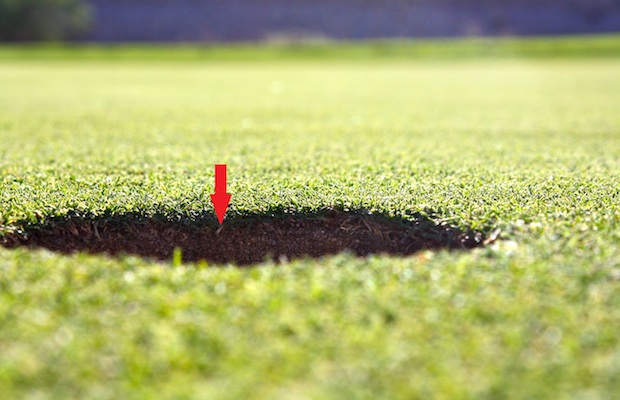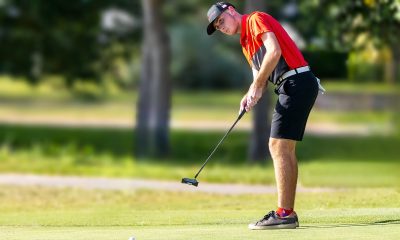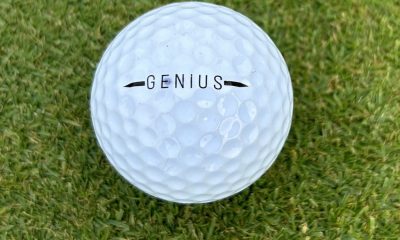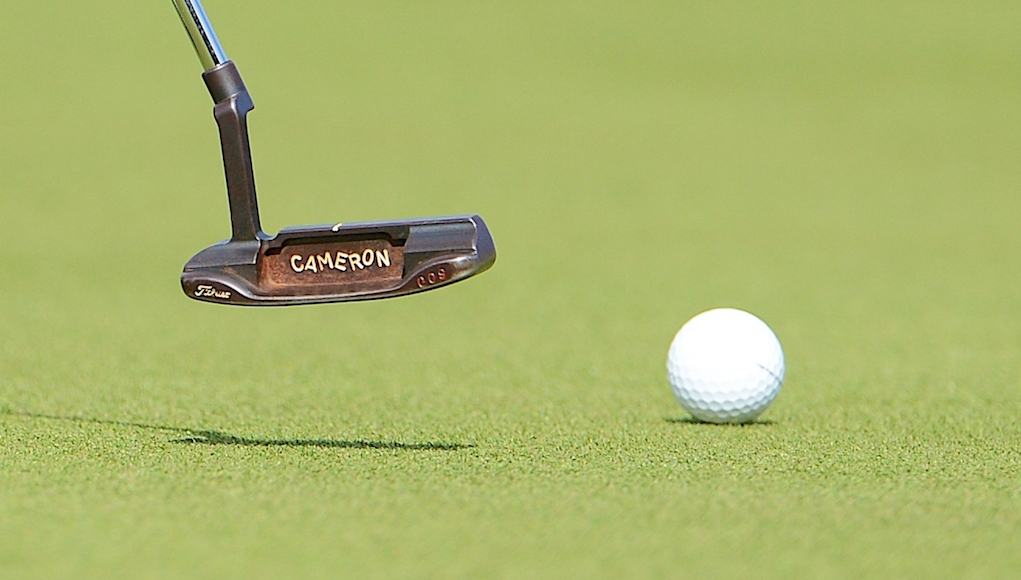Instruction
Beat the yips with these simple tips

The yips is a disease that affects the cognitive process of the brain and disrupts fine motor movement of the body. Golfers are predominantly affected by the disease on short putts, but can also be affected on other shots.
The disease has ruined the careers of numerous professional golfers, and has forced many golfers to quit the game all together. According to the Mayo Clinic, 33-to-48 percent of all serious golfers have experienced the yips, but there’s hope. This disease can be treated with a simple remedy that I have outlined in the paragraphs below.
Acceptance
As with any recovery program, the first step is acceptance. Golfers must accept the fact that they have a cognitive problem that hinders their ability to make short putts. Many golfers who suffer from the yips have tried various grips, putters, techniques, etc., but have not addressed the root cause of the problem, the mind. Once golfers have accepted the fact that the yips are a byproduct of faulty thinking, they can begin a process to treat the problem.
Committing to the Process
The second step is commitment. Committing to a long-term improvement plan is essential in overcoming the yips. The process that I recommend includes developing a pre-shot routine, selecting small targets and making appropriate choices to give oneself the best chance possible.
Related: For more on the pre-shot routine, please read Part 5 of The Ultimate Putting Program.
Pick Small Targets
By selecting small targets, golfers can narrow their focus, providing better accuracy and greater results. An archest aims at the center of the bull’s-eye, and even though he may not always hit the bulls-eye, he almost always hits the larger target.
In golf, picking a blade of grass or a discolored piece of the cup can narrow a golfer’s focus, allowing them to more frequently hit the larger target, the hole. Taking practice strokes while looking at the target and holding an image of the target while making the stroke are sure ways of eliminating the possibility of negative thoughts creeping into the mind. This technique can allow a golfer to find comfort during stressful situations.
On breaking putts, it may be beneficial to pick a target outside of the hole (as shown above), creating a straight putt and allowing gravity to carry the ball to the hole.
Drill
Spend more time looking at the target to capture a mental picture of where you want the ball to go.
In practice, putt while looking at the target. This will immediately change your focus from an internal thought process to an external one. Being more aware of the target is the single most valuable thing that you can do for you golf game.
Make the Choice to Putt Well
“Whether you see yourself making the putt or missing it, you are correct.”
As human beings, one of our greatest assets is the power of free will. In putting, we have two choices. We can either think positively of what we intend to do or we can think negatively of what we fear might happen. The fear of failure is a crippling mental thought that can destroy any golfer. I assume we can all agree that it makes sense to focus positively on what we intend to do. The choice of visualizing oneself making putts comes down to a golfer’s commitment to the target and their faith to allow it to happen.
Note: Those who suffer from the yips often times are more fearful of missing than they are excited by the possibility of making a putt. Embarrassment and verbal harassment from their playing partners are often times the reason for such fear.
Press the Reset Button
If a negative thought enters your mind you must STOP and start over, even if it happens after you address the ball and are almost ready to make a stroke. This is critical in the beginning because you will need to break the habit of continuing with the putt regardless of negative thinking. As you continue with this process, the negative thoughts will begin to disappear and you won’t have to restart as often. Soon you will have more confidence and be putting like you have always thought you should.
Good luck and congratulations on becoming a better putter and overcoming the dreaded yips.
Instruction
The Wedge Guy: Beating the yips into submission

There may be no more painful affliction in golf than the “yips” – those uncontrollable and maddening little nervous twitches that prevent you from making a decent stroke on short putts. If you’ve never had them, consider yourself very fortunate (or possibly just very young). But I can assure you that when your most treacherous and feared golf shot is not the 195 yard approach over water with a quartering headwind…not the extra tight fairway with water left and sand right…not the soft bunker shot to a downhill pin with water on the other side…No, when your most feared shot is the remaining 2- 4-foot putt after hitting a great approach, recovery or lag putt, it makes the game almost painful.
And I’ve been fighting the yips (again) for a while now. It’s a recurring nightmare that has haunted me most of my adult life. I even had the yips when I was in my 20s, but I’ve beat them into submission off and on most of my adult life. But just recently, that nasty virus came to life once again. My lag putting has been very good, but when I get over one of those “you should make this” length putts, the entire nervous system seems to go haywire. I make great practice strokes, and then the most pitiful short-stroke or jab at the ball you can imagine. Sheesh.
But I’m a traditionalist, and do not look toward the long putter, belly putter, cross-hand, claw or other variation as the solution. My approach is to beat those damn yips into submission some other way. Here’s what I’m doing that is working pretty well, and I offer it to all of you who might have a similar affliction on the greens.
When you are over a short putt, forget the practice strokes…you want your natural eye-hand coordination to be unhindered by mechanics. Address your putt and take a good look at the hole, and back to the putter to ensure good alignment. Lighten your right hand grip on the putter and make sure that only the fingertips are in contact with the grip, to prevent you from getting to tight.
Then, take a long, long look at the hole to fill your entire mind and senses with the target. When you bring your head/eyes back to the ball, try to make a smooth, immediate move right into your backstroke — not even a second pause — and then let your hands and putter track right back together right back to where you were looking — the HOLE! Seeing the putter make contact with the ball, preferably even the forward edge of the ball – the side near the hole.
For me, this is working, but I am asking all of you to chime in with your own “home remedies” for the most aggravating and senseless of all golf maladies. It never hurts to have more to fall back on!
Instruction
Looking for a good golf instructor? Use this checklist

Over the last couple of decades, golf has become much more science-based. We measure swing speed, smash factor, angle of attack, strokes gained, and many other metrics that can really help golfers improve. But I often wonder if the advancement of golf’s “hard” sciences comes at the expense of the “soft” sciences.
Take, for example, golf instruction. Good golf instruction requires understanding swing mechanics and ball flight. But let’s take that as a given for PGA instructors. The other factors that make an instructor effective can be evaluated by social science, rather than launch monitors.
If you are a recreational golfer looking for a golf instructor, here are my top three points to consider.
1. Cultural mindset
What is “cultural mindset? To social scientists, it means whether a culture of genius or a culture of learning exists. In a golf instruction context, that may mean whether the teacher communicates a message that golf ability is something innate (you either have it or you don’t), or whether golf ability is something that can be learned. You want the latter!
It may sound obvious to suggest that you find a golf instructor who thinks you can improve, but my research suggests that it isn’t a given. In a large sample study of golf instructors, I found that when it came to recreational golfers, there was a wide range of belief systems. Some instructors strongly believed recreational golfers could improve through lessons. while others strongly believed they could not. And those beliefs manifested in the instructor’s feedback given to a student and the culture created for players.
2. Coping and self-modeling can beat role-modeling
Swing analysis technology is often preloaded with swings of PGA and LPGA Tour players. The swings of elite players are intended to be used for comparative purposes with golfers taking lessons. What social science tells us is that for novice and non-expert golfers, comparing swings to tour professionals can have the opposite effect of that intended. If you fit into the novice or non-expert category of golfer, you will learn more and be more motivated to change if you see yourself making a ‘better’ swing (self-modeling) or seeing your swing compared to a similar other (a coping model). Stay away from instructors who want to compare your swing with that of a tour player.
3. Learning theory basics
It is not a sexy selling point, but learning is a process, and that process is incremental – particularly for recreational adult players. Social science helps us understand this element of golf instruction. A good instructor will take learning slowly. He or she will give you just about enough information that challenges you, but is still manageable. The artful instructor will take time to decide what that one or two learning points are before jumping in to make full-scale swing changes. If the instructor moves too fast, you will probably leave the lesson with an arm’s length of swing thoughts and not really know which to focus on.
As an instructor, I develop a priority list of changes I want to make in a player’s technique. We then patiently and gradually work through that list. Beware of instructors who give you more than you can chew.
So if you are in the market for golf instruction, I encourage you to look beyond the X’s and O’s to find the right match!
Instruction
What Lottie Woad’s stunning debut win teaches every golfer

Most pros take months, even years, to win their first tournament. Lottie Woad needed exactly four days.
The 21-year-old from Surrey shot 21-under 267 at Dundonald Links to win the ISPS Handa Women’s Scottish Open by three shots — in her very first event as a professional. She’s only the third player in LPGA history to accomplish this feat, joining Rose Zhang (2023) and Beverly Hanson (1951).
But here’s what caught my attention as a coach: Woad didn’t win through miraculous putting or bombing 300-yard drives. She won through relentless precision and unshakeable composure. After watching her performance unfold, I’m convinced every golfer — from weekend warriors to scratch players — can steal pages from her playbook.
Precision Beats Power (And It’s Not Even Close)
Forget the driving contests. Woad proved that finding greens matters more than finding distance.
What Woad did:
• Hit it straight, hit it solid, give yourself chances
• Aimed for the fat parts of greens instead of chasing pins
• Let her putting do the talking after hitting safe targets
• As she said, “Everyone was chasing me today, and managed to maintain the lead and played really nicely down the stretch and hit a lot of good shots”
Why most golfers mess this up:
• They see a pin tucked behind a bunker and grab one more club to “go right at it”
• Distance becomes more important than accuracy
• They try to be heroic instead of smart
ACTION ITEM: For your next 10 rounds, aim for the center of every green regardless of pin position. Track your greens in regulation and watch your scores drop before your swing changes.
The Putter That Stayed Cool Under Fire
Woad started the final round two shots clear and immediately applied pressure with birdies at the 2nd and 3rd holes. When South Korea’s Hyo Joo Kim mounted a charge and reached 20-under with a birdie at the 14th, Woad didn’t panic.
How she responded to pressure:
• Fired back with consecutive birdies at the 13th and 14th
• Watched Kim stumble with back-to-back bogeys
• Capped it with her fifth birdie of the day at the par-5 18th
• Stayed patient when others pressed, pressed when others cracked
What amateurs do wrong:
• Get conservative when they should be aggressive
• Try to force magic when steady play would win
• Panic when someone else makes a move
ACTION ITEM: Practice your 3-6 foot putts for 15 minutes after every range session. Woad’s putting wasn’t spectacular—it was reliable. Make the putts you should make.
Course Management 101: Play Your Game, Not the Course’s Game
Woad admitted she couldn’t see many scoreboards during the final round, but it didn’t matter. She stuck to her game plan regardless of what others were doing.
Her mental approach:
• Focused on her process, not the competition
• Drew on past pressure situations (Augusta National Women’s Amateur win)
• As she said, “That was the biggest tournament I played in at the time and was kind of my big win. So definitely felt the pressure of it more there, and I felt like all those experiences helped me with this”
Her physical execution:
• 270-yard drives (nothing flashy)
• Methodical iron play
• Steady putting
• Everything effective, nothing spectacular
ACTION ITEM: Create a yardage book for your home course. Know your distances to every pin, every hazard, every landing area. Stick to your plan no matter what your playing partners are doing.
Mental Toughness Isn’t Born, It’s Built
The most impressive part of Woad’s win? She genuinely didn’t expect it: “I definitely wasn’t expecting to win my first event as a pro, but I knew I was playing well, and I was hoping to contend.”
Her winning mindset:
• Didn’t put winning pressure on herself
• Focused on playing well and contending
• Made winning a byproduct of a good process
• Built confidence through recent experiences:
- Won the Women’s Irish Open as an amateur
- Missed a playoff by one shot at the Evian Championship
- Each experience prepared her for the next
What this means for you:
• Stop trying to shoot career rounds every time you tee up
• Focus on executing your pre-shot routine
• Commit to every shot
• Stay present in the moment
ACTION ITEM: Before each round, set process goals instead of score goals. Example: “I will take three practice swings before every shot” or “I will pick a specific target for every shot.” Let your score be the result, not the focus.
The Real Lesson
Woad collected $300,000 for her first professional victory, but the real prize was proving that fundamentals still work at golf’s highest level. She didn’t reinvent the game — she simply executed the basics better than everyone else that week.
The fundamentals that won:
• Hit more fairways
• Find more greens
• Make the putts you should make
• Stay patient under pressure
That’s something every golfer can do, regardless of handicap. Lottie Woad just showed us it’s still the winning formula.
FINAL ACTION ITEM: Pick one of the four action items above and commit to it for the next month. Master one fundamental before moving to the next. That’s how champions are built.
PGA Professional Brendon Elliott is an award-winning coach and golf writer. You can check out his writing work and learn more about him by visiting BEAGOLFER.golf and OneMoreRollGolf.com. Also, check out “The Starter” on RG.org each Monday.
Editor’s note: Brendon shares his nearly 30 years of experience in the game with GolfWRX readers through his ongoing tip series. He looks forward to providing valuable insights and advice to help golfers improve their game. Stay tuned for more Tips!
























Bruce Rearick
Jun 21, 2014 at 9:57 am
Henry,
I questioned your conclusion? As the author of the column isn’t it your job to prove your conclusions?
To fix a choke – find the mechanical source of the problem. To start assume it is a rotational problem.
To fix the actual yips? You have to change the task mentally and mechanically. Find the source of the yip. Start with the hands. Change the source of your putting motion.
Henry Stetina
Jun 24, 2014 at 10:45 am
Actually, I believe my article clearly emphasizes the point that the yips (or choke) start in the mind. I believe all motion starts in the mind therefore a golfer’s mentality must change prior to making changes to the stroke. I understand there are mechanical flaws but that has already been covered in thousands of articles related to the topic. I don’t quite understand where you’re going with your criticism, but that’s ok, you’re entitled your opinion.
Brannon
Jun 20, 2014 at 2:44 am
Great article! I’ve personally been battling the yips on many fronts but they all started with putting and chipping as I became obsessed with becoming a scratch golfer. I put way too much pressure on myself and results then lost my focus on the process. I’ve been doing a little better recently with that and look forward to trying your great tips. I don’t want to end up another golfer who had to quit the game he loved due to this awful affliction.
Thanks again
LY
Jun 19, 2014 at 10:33 am
I have found that when I putt looking at a spot 1″-2″ in front of the ball on my intended line and not the ball also helps. I focus on that spot and it helps to swing through the ball not at the ball.
Jeremy Beale
Jun 18, 2014 at 5:47 pm
When I stand behind the ball I often think of this Tiger Woods quote:
As a kid, I might have been psycho, I guess, but I used to throw golf balls in the trees and try and somehow make par from them. I thought that was fun.
For me the thrill of golf has always comes from the battle against the agony of defeat and the constant rigor of the course. Nothing says that more than the putting surface–ones final mark on each hole. There is a since of glory that is provided with our victories and a certain pride that comes with defeat of ill expectations.If we are challenged then we know we are playing golf.
However, it still good to remember that off the course everything else is just life, on the course well, we are just playing another game.
Henry Stetina
Jun 18, 2014 at 5:51 pm
Great quote Jeremy! I also like the one about his Dad teaching him to “putt to the picture,” referring to his mental picture of the target.
François
Jun 18, 2014 at 5:46 pm
What would you recommend for the chipping yips ? It is harder to chip while looking at the target i guess?
I have been struggling baddly with this for years 🙁
Henry Stetina
Jun 18, 2014 at 6:02 pm
There will always be a combination between physical and mental when dealing with these issues. I am sure you are plagued with fear, doubt, and low confidence. You may also be using a faulty technique which causes your body and hands to stop and you are left to desperately fling the clubhead towards the ball. If I were you, I would start by making a full pivot toward the target in the forward swing. Mentally, it is important to visualize the trajectory and landing spot. I hope these two tips help.
François
Jun 18, 2014 at 8:14 pm
You are so right about fear and confidence, i use my putter from ridiculous distances because of this… i will try the 2 tips for sure. Thank you
David
Oct 3, 2014 at 2:39 pm
I have suffered from the yips for a number of years to the point the game became miserable. I recently designed a very simple device that attaches to the putter shaft providing a guide towards the target. Putters have markings behind the ball but very little to help the player aim forward. The putting aid creates a smoother stroke because you keep your head down and accelerate through the putt. I believe the guides on the putter behind the ball create deceleration. Since developing the training aid my yips have subsided. Confidence has grown and more putts are on line. Please take a look at http://www.trainyouraim.com It also helps with chipping using the same principle of accelerating through the shot.
Jason
Jun 18, 2014 at 5:38 pm
Henry,
Thank you for taking the time to write this helpful article. I developed the yips nearly 1 year ago (almost to the day as i still remember the round/day it happened) and i’ve been struggling with my game ever since. I anxiously look forward to putting these tips into play this weekend.
I’ve gone from a 1.7 index to a 6.4 in the last year and haven’t broken 80 in almost 3 months. I’ve had too many rounds to count where i’ve shot 80 or 81 with 35+ putts. It’s nauseating.
Henry Stetina
Jun 18, 2014 at 5:53 pm
Jason,
Thanks for sharing. I would really like to hear your progress in the upcoming weeks/months. I hope that something may have clicked to help you get back on track. Good luck
Gene
Jun 18, 2014 at 3:44 pm
Henry, Any help for backswing yips? With an iron in my hand it’s a freak show!
Henry Stetina
Jun 18, 2014 at 5:08 pm
What do you think about just prior and during your swing?
Chuck
Jun 18, 2014 at 3:38 pm
Real yips is focal dystonia (google it). Focusing on a spot and changing your routine isn’t going to make it magically go away. It’s a neurological problem that takes years of cognitive training to cure – beta blockers can also help. I now play tennis.
Henry Stetina
Jun 18, 2014 at 4:54 pm
Yes, I am aware focal dystonia is a neurological disorder and in sports it is referred to as the yips. Beta blockers slow the heart rate and are banned by the PGA Tour. Meditation, a natural practice, can have a similar result though.
Steve
Jun 18, 2014 at 11:36 am
Great article.. I used to have occasional negative thoughts over putts, but I would ignore them and make a reasonable stroke. Starting last year, I’ve noticed that these negative thoughts sometimes cause a sort of “misfire” in my stroke. It feels like a flinch just before impact, and it seems to happen mainly in competition or when my long game is going well and I have a chance to match or beat my personal best score.
It is definitely a cognitive issue not a mechanical one.
Thanks for writing it.
Henry Stetina
Jun 18, 2014 at 12:26 pm
Great feedback Steve. You are definitely on the road to better golf.
Bruce Rearick
Jun 18, 2014 at 11:02 am
Small targets for someone with the yips?
Steve
Jun 18, 2014 at 11:40 am
Focus on the target is the key. If I look at the hole while putting, the yips are gone, but my speed control is hit or miss. Focusing on the stroke mechanics in matches spells trouble for me.
Henry Stetina
Jun 18, 2014 at 12:27 pm
Aim small, miss small
Bruce Rearick
Jun 18, 2014 at 2:09 pm
Not if you really have the yips. There is a difference between a yip and a choke. For those who truly have the “yips” this information is misleading at best.
Henry Stetina
Jun 18, 2014 at 5:07 pm
Bruce,
I see you are becoming a constant critic of my work. I like your feedback but I would also like to share one point with you. Don’t point out a problem without a solution. If you see fault in my articles, feel free to comment on them, but please provide an alternative, an idea that you believe is more accurate.
Bruce Rearick
Jun 20, 2014 at 1:02 pm
OK –
Small targets increase the anxiety of the task. Anxiety exaggerates the problem it doesn’t fix it.
Yips are an involuntary uncontrollable movement.
Your tips are better suited for a player who has an aggressive steer or reaction to a perceived target. This is typically a rotational issue. Closing the putter on the backswing is the typical culprit. Another choke pattern is a flip which is caused by a slow lead arm and an attempt of the low hand to continue the stroke. These patterns are more commonly described by experts in the field as a “choke”.
Knowing the difference between the two is critical! As the anxiety increases from the misses caused by the choke they can easily develop into the real yips. Nothing described in you article would of any help then.
Bruce Rearick
Henry Stetina
Jun 20, 2014 at 5:01 pm
Ok. So with that said, what is your prescription for someone with the yips?
Pingback: Beat the yips with these simple tips - I'd Rather Be Golfing
Adrian
Jun 18, 2014 at 3:46 am
Archest? Don’t you mean ‘archer’?!
Henry Stetina
Jun 18, 2014 at 12:25 pm
Yes, my apologies.